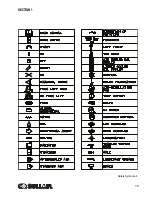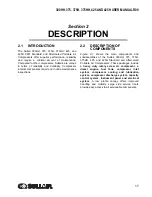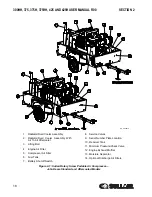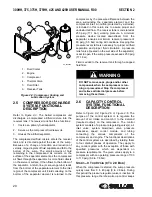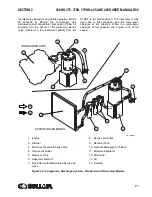
SECTION
1
10
is spilled on skin or clothing, immediately flush
with large quantities of water.
H.
Ethyl ether used in diesel engine ether starting
aid systems is toxic, harmful or fatal if swallowed.
Avoid contact with the skin or eyes and avoid
breathing the fumes. If swallowed,
DO NOT
induce vomiting and call a physician immediately.
I.
Wear goggles or a full face shield when testing
ether starting aid systems or when adding anti-
freeze compound to air line anti-icer systems.
Keep openings of valve or atomizer tube of ether
starting aid system pointed away from yourself
and other personnel.
J.
If ethyl ether or air line anti-icer system anti-
freeze compound enters the eyes or if fumes irri-
tate the eyes, they should be washed with large
quantities of clean water for 15 minutes. A physi-
cian, preferably any eye specialist, should be
contacted immediately.
K. DO NOT
store ether cylinders or air line anti-icer
system antifreeze compound in operator’s cabs
or in other similar confined areas.
L.
The antifreeze compound used in air line anti-
icer systems contains methanol and is toxic,
harmful or fatal if swallowed. Avoid contact with
the skin or eyes and avoid breathing the fumes. If
swallowed, induce vomiting by administering a
tablespoon of salt in a glass of clean warm water.
Do this until vomit is clear, then administer two
tablespoons of baking soda in a glass of clean
water. Have patient lay down and cover eyes to
exclude light. Call a physician immediately.
1.8
ELECTRICAL SHOCK
A.
Keep the towing vehicle or equipment carrier,
compressor hoses, tools and all personnel at
least 10 feet (3 m) from power lines and buried
cables.
B.
Keep all parts of the body and any hand-held
tools or other conductive objects away from
exposed live parts of electrical system. Maintain
dry footing, stand on insulating surfaces and
DO
NOT
contact any other portion of the compressor
when making adjustments or repairs to exposed
live parts of the electrical system.
C.
Attempt repairs only in clean, dry and well-lighted
and ventilated areas.
D.
Stay clear of the compressor during electrical
storms! It can attract lightning.
1.9
LIFTING
A.
If the compressor is provided with a lifting bail,
then lift by the bail provided. If no bail is provided,
then lift by sling. Compressors to be air lifted by
helicopter
must not
be supported by the lifting
bail, but by slings instead. In any event, lift only in
full compliance with OSHA Standards 29 CFR
1910 subpart N or any other Local, State, Military
and Federal regulations that may apply.
B.
Inspect lifting bail and points of attachment for
cracked welds and for cracked, bent, corroded or
otherwise degraded members and for loose bolts
or nuts prior to lifting.
C.
Make sure entire lifting, rigging and supporting
structure has been inspected, is in good condi-
tion and has a rated capacity of at least the net
weight of the compressor plus an additional 10%
allowance for weight of water, snow, ice, mud,
stored tools, and equipment. If your are unsure
of the weight, then weigh compressor before lift-
ing.
D.
Make sure lifting hook has a functional safety
latch or equivalent, and is fully engaged and
latched on the bail.
E.
Use guide ropes or equivalent to prevent twisting
or swinging of the compressor once it has been
lifted clear of the ground.
F. DO NOT
attempt to lift in high winds.
G.
Keep all personnel out from under and away
from the compressor whenever it is suspended.
H.
Lift compressor no higher than necessary.
I.
Keep lift operator in constant attendance when-
ever compressor is suspended.
J.
Set compressor down only on a level surface
capable of supporting at least its net weight plus
an additional 10% allowance for the weight of
water, snow, ice, mud, stored tools, and/or equip-
ment.
K.
If the compressor is provided with parking
brakes, make sure they are set, and in any
event, block or chock both sides of all running
wheels before disengaging the lifting hook.
Summary of Contents for 300HH
Page 17: ...SECTION 1 15 Safety Symbols 2 ...
Page 18: ...SECTION 1 16 Safety Symbols 3 ...
Page 49: ...SECTION 2 300HH 375 375H 375HH 425 AND 425H USER MANUAL R00 47 2 9 WIRING DIAGRAM ...
Page 60: ...NOTES 58 ...
Page 79: ...NOTES ...

















